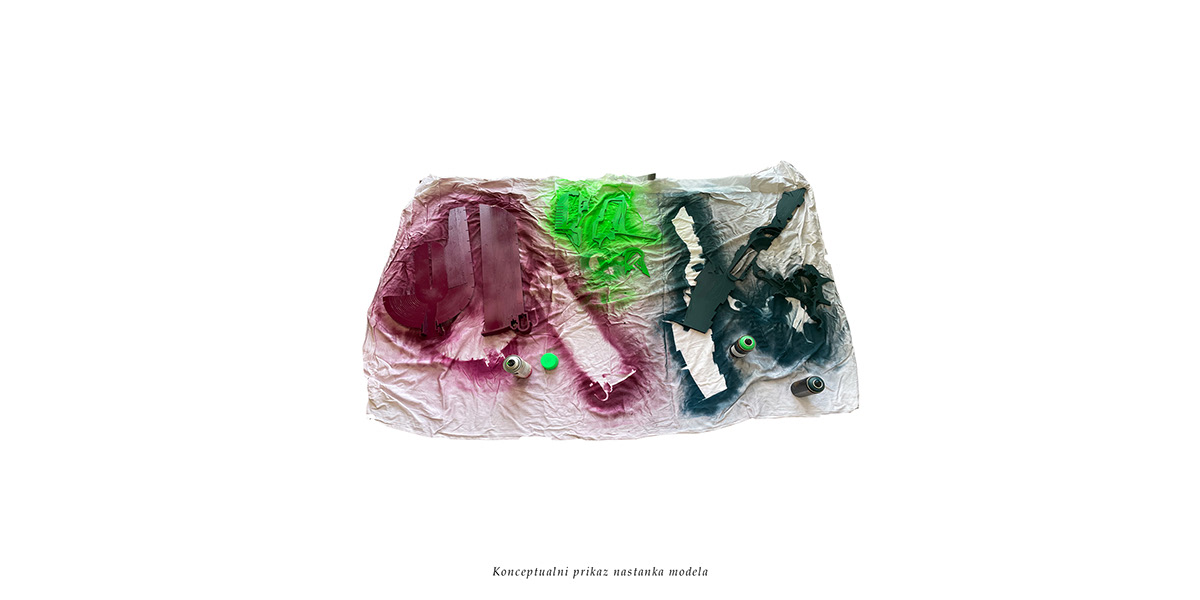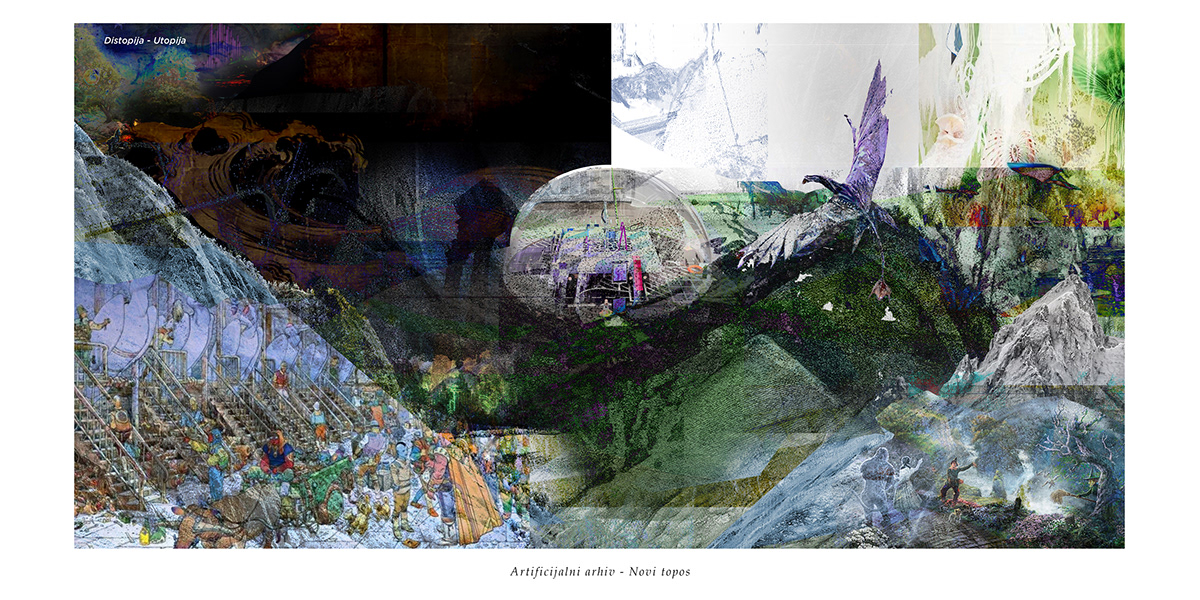

Fantastic landscapes/ Dreamscapes: Archiving fragments of imagination
How people want to remember and be remembered
The research's fundamental premise is rooted in the need to perceive archaeological remains of former cities/territories not merely as relics of the past but as vital elements with the power to influence our present and future. Through an innovative interpretative approach and an experimental format, heritage becomes a key that highlights the importance of reusing and interpreting their fragments, allowing the past to be seen as an unstable phenomenon in constant evolution. This, in turn, broadens the general notion of time as a transient existence that "returns" by transcending itself towards future existence.
According to Jean Baudrillard, within a specific context, nothing is truly "real," although those caught in the illusion cannot see it. Instead of experiencing reality directly, people observe spectacles through real or metaphorical control screens, reflecting the concept of the map-territory relationship. The territory no longer precedes the map nor can it maintain a comparative status. The map becomes the one that precedes the territory – the precession of the simulacrum (Jean Baudrillard, Simulacra and Simulation). This refers to the idea that the map, as a concept of the territory, actually precedes the immediate experience and existential space of the territory as direct reality. Thus, the idea or model of reality becomes an entity that shapes our perception and understanding of real space – it becomes an instruction for the "use" and experience of the territory; constructing a logical framework and prescriptive model. The map is no longer a reflection of reality but a simulation that reaches its final stage by losing the territory as a real reference. So, what do archaeological maps and drawings of long-lost and forgotten territories and cities tell us?
The project's concept is a call for the creation and discovery of new types of natural and public spaces within the expanded urban realm of Sirmium, invoking new, surreal, experimental public domains, where humans are no longer users/residents but farmers, collectors, cartographers, explorers, archaeologists... Sirmium, one of the most significant Roman cities in the Pannonian region, often referred to as the Pannonian metropolis in literature, lies in its entirety beneath the surface of present-day Sremska Mitrovica. The historical richness of the city and its growth over the centuries have been built on exploration, exploitation, and transformation of the city and nature. Sirmium represents an ideal that owes its indestructibility to its imperfection and incompleteness. The city as a city is not much, but the dream of the city is another matter. The proposal envisions a reimagining of the Sirmium area, the geographic center of this transformation, as a place where the incompleteness of memory and unpredictability of imagination are celebrated – shaped by fantasies of liberation, fragmented connections of stories/narratives and images – a synthesis of collective imagination and collective memory. Through thoughtful transformation, heritage spaces find new or transformed functions. "Mapping" our mental space reveals existing and invisible structures, predicting those yet to be established, indicating their possible spatial configurations. The vastness of the territory achieved through this balance can deceive individuals: Is it a project? Is it a historical accident? Is it a return to some past period or a journey into the future? Amidst these fragments of landscapes, there is no resemblance in form – they all represent a haven for diversity, liberating us from all familiar narratives, causing complete unpredictability and freedom of the mind.
Left in the interstitial space, neither near nor far; thus, we arrive at the crucial question and attempt to answer it:
How do people want to remember and be remembered?


An allegorical interpretation of fragments can be used to generate dream landscapes, where multiple voices can be heard together, even when spoken from different times, different worlds - thus transcending ideas of utopia or dystopia/speculative fiction - complementing, expanding, and unlimiting - merging worlds. A state where reality and fiction are hard to distinguish, more real than reality, thrilling, extreme - exaggerated. These landscapes can be anywhere, they can exist or be products of imagination, perhaps outlines of a distant memory from a dream's scene or a snippet of scenery caught by the eye; they can belong to everyone and no one, everywhere and nowhere, here and now or nowhere and never - maybe sometime. Transcending the idea of utopia and dystopia - speculative fiction/heterotopia; a universe that complements, expands, and unlimits, merging worlds.


The Anatomy of (Fantastic) Landscapes focuses on abandoned, forgotten, lost, and seemingly distant terrains of unknown geographical coordinates. Among such landscape fragments, there is no similarity in form; Only one common point: they all represent a refuge for diversity - elsewhere, diversity is banished. Thus, we are liberated from all familiar narratives, resulting in complete unpredictability and freedom of the mind. Left in the interstitial space, neither near nor far. Lost/Invisible Cities - non-existent places of infinite possibilities, rejecting conventions of form and narrative to emphasize ideas of memory and place. A synthesis of collective imagination and collective memory; embodying all ideas we hold about ourselves and society. They materialize through the denial of time's definition as irreversible, seen as a medium of identification, recovery, future, and moral promise. Regarding the city as a place for living, it is a very ancient matter. Why did humans invent the city to suffer in it? The city - a deprived earthly paradise; Poetically, the city can be viewed as a stage of urban, spatial, and social identities, which are also present in theaters. The urban identity - the symbolic face of the city, is a set of characteristics that define and make it recognizable in comparison to other urban areas. On the other hand, it can be seen as an impression of the city that evokes a sense of ambient, historical, socio-cultural, and spatial values among its inhabitants.



Alegorijski pojmovnik fragmenata lokacije / A Glossary of Allegorical Concepts of Location: Selected fragments/segments of treated elements of architectural heritage are regarded as indispensable parts of the whole.


In this process of creation, space establishes a relationship with a specific dimension, and it reaches a moment when it becomes self-referential and generates its own changes. The development of a methodology for designing a themed park complex - a space of spectacle; a comparative analysis of methods used for the conservation of archaeological artifacts and archival materials and the possibilities of their programmatic cohesion. The themed park acts as a catalyst for regeneration. One of the assumptions is that cultural heritage in the modern age plays the role of a new tectonic layer, through which further shaping becomes possible. By overlapping the physical and atmospheric requirements for preserving the entire heritage, the goal is to identify micro-ambiences (fragments) that constitute the programmatic units of the themed park - the space of spectacle. Ruins manifest themselves as a kind of time capsules, providing a distinct insight into the existence and culture of vanished civilizations, where there is a symbolic connection between architecture and time; architecture becomes the primary tool for representation. The objective is to develop a new fantastic dreamscape as a panorama and spectacle, becoming a new physical and metaphysical landmark in both narrower and broader contexts.
The selected fragments represent:
The program of architectural heritage, which transforms from infrastructure into a system of artifacts with high cultural significance. The system of reference searching related to knowledge and classification (filtering) of information.The defined fragments of architectural heritage are "reprogrammed" through programmatic experiments, after which the newly created elements are combined to create the hints of spaces. The physical space as such becomes a cluster of fragments that allows for subjective perception and emphasizes their primary quality.



















University of Belgrade- Faculty of Architecture 2022/23
Master thesis and project - Sofija Spaić
Mentorship: v. prof. Aleksandru Vuja


